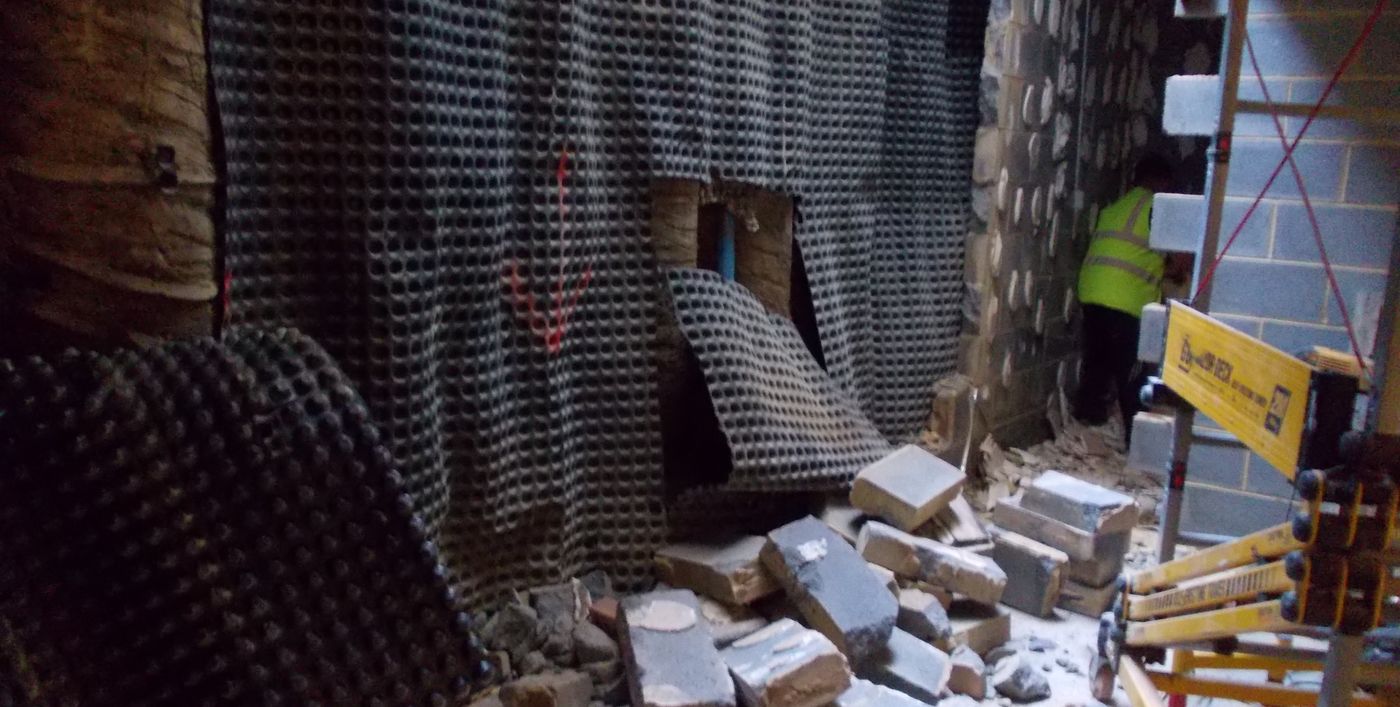01732 360 095
Contiguous piles are an efficient and cost-effective means of creating retaining structures. However, while they avoid excessive excavation and assist in the control of ground movement, the risk of groundwater ingress between the piles can be significant.
Therefore, in order to preserve and maintain internal walls and finishes, it is extremely important to ensure that contiguous piles are correctly and competently waterproofed. David Bucknell of Newton Waterproofing Systems considers the best, as well as an example of the worst, methods for effectively waterproofing such a structure.
When considering the waterproofing requirements of any structure, there are two fundamental questions that must be asked before anything else:
- What is the structure in question constructed from?
- What is the expectation of the waterproofing?
It is only once the answers to these questions have been established that the Type of waterproofing can be agreed upon – be it Type A, B or C as defined within British Standard 8102:2022(1) – or a combination of two or three of these.
At Newton Waterproofing we frequently see designs that propose the application of a cuspated drainage membrane directly to the surface of the contiguous piled walls. Without question, this is an extremely dangerous practice and should never be contemplated, due to the fact that:
- There is (technically) no structure, piles could have been chosen as the construction method for a number of reasons, such as a tight construction line or in order to achieve the desired depth. However, from a waterproofing perspective contiguous piles are not, and cannot be considered as, a structure.
- Simply applying a cuspated membrane to the piles does not create Type C waterproofing or ‘drained protection’. The British Standard makes it explicitly clear as to the standards that should be achieved by a retaining structure, stating that, “the outer leaf of the exterior wall should be capable of controlling the quantity of water that can pass through it, in order not to exceed the drainage capacity of the system. Water entering a drained cavity system is regulated by the structure, so defects that might result in unacceptable leaks should be remedied before the system is installed”.
- A contiguous piled structure makes it impossible to achieve any of the three internal environmental grades, as defined within BS 8102:2022, because of the potential for large volumes of water to pass through the gaps between the piles.

Figure 1: The cuspated drainage membrane has bowed away from the contiguous piled wall, causing the complete collapse of both the inner wall and the inner spine wall.
In short, it impossible to achieve a successful waterproofing system by simply applying a drainage membrane to the piles. Such an approach is not only inadvisable in theory; in practice it can also lead to a complete structural failure, as is evident in both Figures 1 and 2.
What Should Be Done?
In the project shown in Figures 1 and 2, the aim was to achieve a completely dry and habitable Grade 3 internal environment. However, in order to achieve this, the first thing that needs to be created is an acceptable and capable structure. In the case of contiguous piles, first and foremost this means that the gaps between the piles should be of suitable dimension for the type of ground they are retaining and then grouted in order to prevent the sort of slumping that is clearly visible in Figure 2.
Correctly Designed
With correctly designed and constructed contiguous piles in place – which, once excavated, have been well prepared – a combined approach to waterproofing protection, with two or more of the Types, is a vital consideration. This combined approach is a significant recommendation of the British Standard, especially when, as can be the case with contiguous piles, “the likelihood of leakage is high” and even more so when trying to achieve a Grade 3 internal space where “no water penetration is acceptable”.
Therefore to begin with, hydrophilic polymer membranes such as HydroBond 403 Plus provide an effective and self-healing Type A waterproof barrier. Such membranes are pre-applied to the contiguous piles as well as being laid across the floor and, once placed, the locking fleece on the internal surface of the membrane forms a mechanical bond with the cast-in-place concrete raft reinforced liner walls.

Figure 2: With the membrane cut away, it is easy to see how the earth, which should have been retained by the structure and probably carried by groundwater, has slumped to the bottom of the piles, causing the internal wall to collapse.
When placing a concrete structure that conforms to BS EN 1992(2), Type B waterproofing can also be achieved by the inclusion of waterbars at the kicker and/ or construction joints, thereby providing a combined solution of Types A and B.
Interestingly, a well-designed and well-placed reinforced concrete structure, with the inclusion of waterbars in the construction joints to preclude water, should not require the inclusion of admixtures in order to achieve Type B waterproofing. Good-quality concrete is inherently water-resistant and the addition of an admixture is unlikely to prevent leakage at the joints.
With both Types A and B waterproofing already in place, the final and failsafe barrier to water ingress is to apply Type C waterproofing internally in the form of a cavity drainage system. This method not only accepts that water could enter the structure, it does nothing to resist the ingress, instead depressurising the water upon entry and harmlessly managing it away from the structure.

Figure 3: Newton HydroBond 403 Plus is a self-healing Type A waterproofing membrane that can be applied directly to contiguous piles.
Waterproofing Design Specialists
The effective waterproofing of below ground structures always requires a well-defined strategy and contiguous piles are no different. This approach is most effectively co-ordinated by a waterproofing design specialist, a role that the British Standard suggests should be included as an essential part of the design team, to ensure that an integrated waterproofing solution is realised.
Such a specialist will be capable of devising a tailored solution to accommodate the constraints and requirements of individual projects, as well as providing the design team with the necessary information to assist with the design, installation and future maintenance of the waterproofed structure.
In the case of contiguous piles where an internal Grade 3 environment is being sought, the recommendation of such a specialist will always be for a combined approach that is correctly and competently installed, and not just a directly applied cuspated membrane.
References:
1. BRITISH STANDARDS INSTITUTION, BS 8102:2022. Code of practice for the protection of below ground structures against water ingress. BSI, London, March 2022.
2. BRITISH STANDARDS INSTITUTION, BS EN 1992-3. Eurocode 2. Design of concrete structures. Part 3 – Liquid retaining and containing structures. BSI, London, 2006.
Speak to our friendly, expert team
Our staff are able to provide guidance for projects of all sizes, whether you require some general advice about damp or waterproofing, or support with technical drawings and specifications.













